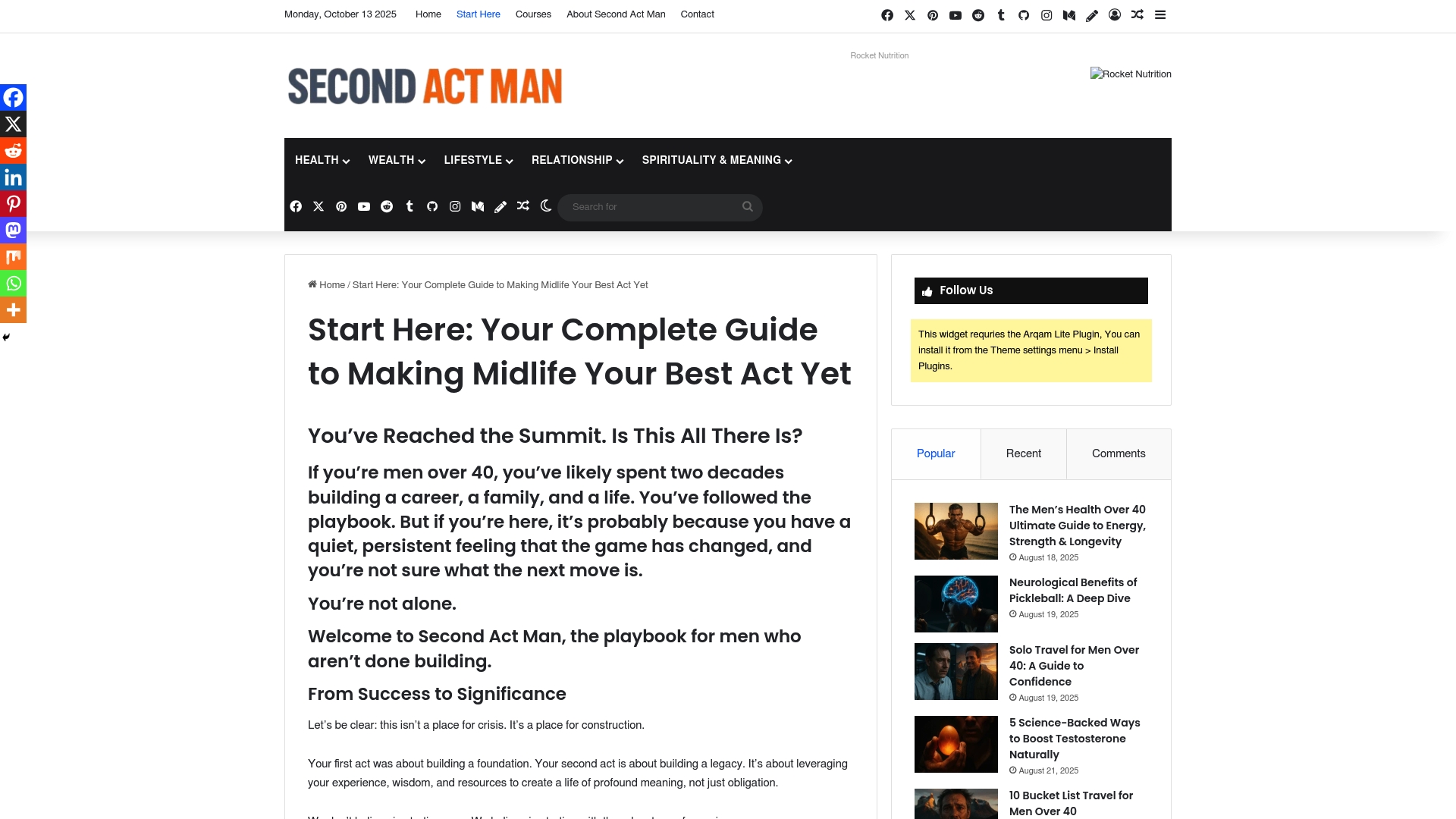7 Fitness Challenges for Men Over 40 to Reinvent Health

Did you know that over 70 percent of men over 40 report struggling to maintain consistent fitness habits? As your body changes with age, so do its needs and limits. Prioritizing smart goal setting, muscle health, flexibility, regular movement, nutrition, and effective tracking can be the difference between frustration and lasting results. Discover practical steps designed to help you thrive, stay motivated, and take charge of your health through your 40s and beyond.
Table of Contents
- Set Realistic And Achievable Fitness Goals
- Incorporate Strength Training For Muscle Health
- Prioritize Flexibility And Joint Mobility
- Adopt Consistent Cardiovascular Workouts
- Focus On Balanced Nutrition And Hydration
- Monitor Progress With Simple Tracking Tools
- Stay Motivated Through Social Support And Accountability
Quick Summary
| Takeaway | Explanation |
|---|---|
| 1. Set realistic fitness goals | Break down your ultimate health objectives into small, specific, and attainable mini goals to increase your chances of success. |
| 2. Incorporate strength training regularly | Aim for two to three weekly sessions focusing on compound movements to maintain muscle health and functional fitness. |
| 3. Prioritize flexibility and mobility | Spend 10-15 minutes daily on flexibility routines to prevent injury and improve movement efficiency. |
| 4. Establish consistent cardiovascular workouts | Incorporate 20-30 minute sessions of moderate activities like brisk walking or swimming, three to four times a week. |
| 5. Monitor progress with tracking tools | Use digital apps and wearable devices to track performance metrics and adjust your fitness goals accordingly. |
1. Set Realistic and Achievable Fitness Goals
As a man over 40, transforming your fitness journey starts with setting smart and sustainable goals that match your current physical condition. Forget about the unrealistic gym fantasies or comparing yourself to twenty something fitness models. Your approach needs to be strategic and personalized.
Research shows that breaking down your ultimate health objective into small, specific, and attainable mini goals dramatically increases your chances of success. According to health experts, keeping a training diary can help you monitor progress and maintain motivation. This means tracking not just your workouts, but how you feel, your energy levels, and incremental improvements.
Before diving into any new fitness program, consulting with a healthcare professional is crucial especially if you have existing health conditions or have been sedentary. These professionals can help you design a safe and progressive workout plan that considers your unique physical profile.
Here are practical steps to set achievable fitness goals:
- Start with a comprehensive health assessment
- Define clear, measurable objectives (e.g., walk 10,000 steps daily)
- Create a 90 day progression plan with incrementally challenging milestones
- Schedule regular check ins with yourself to adjust goals
- Celebrate small victories along the way
Adaptive goal setting techniques can transform your approach. As research from adaptive fitness studies indicates, personalized goals that become incrementally more challenging can effectively motivate sedentary individuals to embrace regular exercise.
Are you ready to rewrite your fitness narrative? What small step will you take today toward your health transformation?
2. Incorporate Strength Training for Muscle Health
As a man over 40, your muscles are not just about looking good they are about maintaining fundamental health and independence. Strength training becomes a critical strategy to protect your body against age related muscle loss and functional decline.
According to Harvard Health research, strength training does far more than build muscle. It helps manage and prevent serious health conditions like heart disease, diabetes, arthritis, and osteoporosis. Think of it as an investment in your long term physical resilience.
Research demonstrates that machine based resistance training can significantly improve functional capacity in older adults. This means you are not just lifting weights you are building the strength needed to perform everyday tasks with ease and confidence.
Here are practical strategies to incorporate strength training safely:
- Start with lightweight resistance and proper form
- Focus on compound movements that engage multiple muscle groups
Key Muscle Groups to Target
Prioritize exercises that work your:
- Legs (squats, leg presses)
- Back (rows, pullups)
- Chest (pushups, bench press)
- Core (planks, stability exercises)
Consider exploring our home gym equipment guide to help you get started with the right tools for your fitness journey.
Remember this is about sustainable progress. Two to three strength training sessions per week can dramatically improve your muscle health, metabolism, and overall functional fitness. Are you ready to reclaim your strength and redefine what it means to be fit after 40?
3. Prioritize Flexibility and Joint Mobility
As men over 40, your body demands a different approach to movement. Flexibility and joint mobility are not optional extras they are essential components of maintaining your physical performance and preventing injury.
Research from Harvard Health reveals that incorporating flexibility exercises can dramatically improve your overall movement efficiency. Think of your body like a well maintained machine joints need regular lubrication and movement to function optimally.
Modern lifestyles characterized by prolonged sitting and poor ergonomics create significant muscle imbalances. These imbalances can lead to chronic pain decreased mobility and increased risk of injury. By prioritizing flexibility and joint mobility you are essentially performing preventative maintenance on your body.
Key Benefits of Mobility Training
- Reduces risk of muscle strain
- Improves posture and body alignment
- Enhances overall physical performance
- Decreases joint pain and stiffness
Practical strategies for improving mobility include:
- Daily dynamic stretching routines
- Yoga or Pilates classes
- Foam rolling techniques
- Mobility specific warm up exercises
Consider targeting these critical areas:
- Shoulders and upper back
- Hip flexors
- Lower back
- Ankle and knee joints
A consistent mobility practice takes just 10 to 15 minutes daily but can transform how your body feels and functions. Our midlife health blueprint offers additional insights into comprehensive wellness strategies.
Remember mobility is not about becoming a contortionist. It is about creating a resilient body that moves with ease and confidence. Are you ready to unlock your body’s full potential?
4. Adopt Consistent Cardiovascular Workouts
Cardiovascular fitness becomes increasingly critical as you enter your 40s. Your heart is a muscle that demands consistent training to maintain peak performance and reduce the risk of metabolic diseases.
Research indicates that regular cardiovascular exercise is a powerful predictor of long term health. Modern technology like wearable devices can now help you monitor and track your fitness levels with unprecedented precision. This means you can create a data driven approach to maintaining your cardiovascular health.
The goal is not to become an elite athlete but to establish a sustainable routine that keeps your heart strong and your metabolism efficient. Adaptive exercise strategies can help you progressively challenge your cardiovascular system without overwhelming it.
Cardiovascular Workout Options
Consider these low impact cardiovascular activities perfect for men over 40:
- Brisk walking
- Swimming
- Cycling
- Rowing
- Elliptical training
Key principles for effective cardiovascular training:
- Start with 20 to 30 minute sessions
- Maintain a moderate intensity where you can still hold a conversation
- Aim for 3 to 4 sessions per week
- Gradually increase duration and intensity
An emerging trend supported by research involves using adaptive AI health coaching techniques. These approaches can generate personalized exercise goals that automatically adjust based on your progress. Our home gym equipment guide can help you find tools to support your cardiovascular journey.
Remember cardiovascular health is not about punishing workouts. It is about consistent movement that makes you feel energized and strong. Are you ready to transform your heart health?
5. Focus on Balanced Nutrition and Hydration
Nutrition after 40 is not just about eating less. It is about strategic fueling for your body’s changing metabolic needs. Your diet becomes a powerful tool for maintaining muscle mass, energy levels, and overall health.
Recent research demonstrates a powerful synergy between balanced nutrition and physical activity. Combining a protein rich diet with regular exercise can significantly increase muscle mass in older adults. This means the food you consume is not just calories but building blocks for sustained strength and functionality.
Protein plays a critical role in muscle protein synthesis. When combined with quality sleep and consistent physical activity, your body can more effectively repair and build muscle tissue. Think of nutrition as your body’s maintenance and repair program.
Key nutritional strategies for men over 40:
- Prioritize lean protein sources
- Include complex carbohydrates
- Consume healthy fats
- Eat multiple smaller meals
- Stay consistently hydrated
Hydration Fundamentals
Water is not optional. It is essential for:
- Regulating body temperature
- Supporting metabolic processes
- Maintaining joint health
- Facilitating muscle recovery
Aim to drink at least 8 to 10 glasses of water daily. Your urine color is a quick hydration indicator. Pale yellow means you are on the right track.
Consider exploring our guide on supplements for men over 40 to complement your nutrition strategy.
Remember nutrition is not about perfection. It is about consistent, intelligent choices that support your body’s changing needs. Are you ready to fuel your second act?
6. Monitor Progress with Simple Tracking Tools
Tracking your fitness journey is not about obsession. It is about creating accountability and understanding your body’s unique performance metrics. In your 40s, data becomes your ally in making smarter health decisions.
Recent technological advancements have transformed how we monitor fitness progress. Wearable devices now offer sophisticated ways to track cardiorespiratory fitness over time. These tools provide more than just numbers they offer insights into your body’s adaptation and improvement.
An emerging trend in fitness tracking involves adaptive AI health coaching. These intelligent systems can generate personalized exercise goals, track your progress, and dynamically adjust recommendations based on your performance. This means your tracking tool becomes a smart companion in your fitness journey.
Effective tracking methods for men over 40:
- Digital fitness apps
- Wearable heart rate monitors
- Body composition scales
- Weekly progress photos
- Performance journals
What to Track
Focus on measuring:
- Resting heart rate
- Body fat percentage
- Strength progression
- Energy levels
- Sleep quality
Consider our protein powder comparison guide to complement your tracking strategy and understand how nutrition supports your fitness metrics.
Remember tracking is not about perfection. It is about understanding your body’s unique language and responding intelligently. Are you ready to become the most informed version of yourself?
7. Stay Motivated Through Social Support and Accountability
Motivation is not a solo sport. Your fitness journey becomes exponentially more powerful when you create a support network that keeps you accountable and inspired through life’s inevitable challenges.
Research demonstrates that social support can dramatically increase your likelihood of maintaining an exercise routine. Interactive coaching systems and community connections provide psychological reinforcement that transforms sporadic effort into consistent progress.
Modern technology offers innovative ways to build accountability. AI health coaching platforms can provide personalized interactive support that adapts to your specific fitness goals. These systems track your progress and offer encouragement precisely when you need it most.
Strategies for building your motivation ecosystem:
- Join fitness classes
- Find an accountability partner
- Participate in online fitness communities
- Share goals with friends and family
- Schedule regular check ins
Accountability Techniques
Effective ways to stay committed:
- Set public goals
- Use social media fitness challenges
- Work with a personal trainer
- Track progress with friends
- Create friendly fitness competitions
Our midlife health blueprint offers additional strategies for maintaining motivation through life transitions.
Remember accountability is not about perfection. It is about creating a supportive environment that makes showing up easier than giving up. Are you ready to transform your fitness journey through connection?
Below is a comprehensive table summarizing the key fitness strategies for men over 40, focusing on goal setting, strength training, flexibility, cardiovascular workouts, nutrition, progress tracking, and motivation.
| Strategy | Implementation | Benefits/Outcomes |
|---|---|---|
| Set Realistic Goals | Conduct a health assessment, define clear objectives, create a 90-day plan | Increases success rate, sustainable progress |
| Incorporate Strength Training | Use lightweight resistance, focus on compound movements | Protects against muscle loss, enhances functional capacity |
| Prioritize Flexibility | Engage in daily stretching, yoga, and foam rolling | Reduces injury risk, improves posture and performance |
| Adopt Cardiovascular Workouts | Aim for 20-30 minute sessions, moderate intensity | Enhances heart health, aids metabolism |
| Focus on Balanced Nutrition | Prioritize protein, include healthy fats and hydration | Supports muscle mass, energy, and repair |
| Monitor Progress | Use fitness apps, wearable monitors, and journals | Enhances accountability, informed health decisions |
| Stay Motivated | Join fitness classes, find accountability partners | Increases consistency, support network boosts adherence |
Take Control of Your Fitness Journey After 40 Today
The challenges men face after 40 can feel overwhelming. From setting realistic fitness goals that match your lifestyle to maintaining strength and flexibility while supporting cardiovascular health, the journey requires thoughtful planning and support. This article highlights how creating sustainable routines and tracking progress are keys to success. If you are ready to break free from frustration and build a strong, healthy future, you do not have to do it alone.

Discover expert guidance and proven strategies tailored just for men over 40 with Fitness After 40 for Men: Workout Routines, Strength Training & Exercise Plans. Navigate your health transformation confidently by exploring our comprehensive resources at Second Act Man and gain deeper insights into holistic wellness with Men’s Health Over 40: A Practical Guide to Fitness, Hormones & Vitality. Your next chapter starts now. Take that first step today and reinvent your health with purpose.
Frequently Asked Questions
What are some realistic fitness goals for men over 40?
Setting realistic fitness goals involves evaluating your current health condition and breaking it down into manageable milestones. Start by defining specific objectives, like walking 10,000 steps daily, and create a 90-day plan to achieve them.
How can strength training benefit men over 40?
Strength training is essential for men over 40 as it helps prevent age-related muscle loss and maintains overall health. Aim for two to three strength training sessions weekly, focusing on major muscle groups such as legs and core, to enhance your functional fitness.
Why is flexibility important for men in their 40s?
Flexibility is crucial for maintaining mobility and preventing injury as you age. Incorporate daily stretching or yoga sessions, focusing on key areas like hips and shoulders, for just 10-15 minutes to significantly improve your overall movement efficiency.
How can I track my fitness progress effectively?
To track your fitness progress, use methods such as wearable devices or fitness apps to monitor metrics like body fat percentage and strength gains. Regularly record your performance and use that data to adjust your training program, checking in weekly to assess your improvements.
What types of cardiovascular exercises should men over 40 consider?
Men over 40 should engage in low-impact cardiovascular exercises like brisk walking, swimming, or cycling. Aim for 3 to 4 sessions per week, starting with 20 to 30 minutes, gradually increasing duration and intensity to support your heart health.
How can I stay motivated on my fitness journey after 40?
Staying motivated involves building a support network through classes or accountability partners. Set public fitness goals and engage in friendly competitions to maintain commitment while celebrating your achievements along the way.
Recommended
- The Midlife Man’s Blueprint for Men’s Health Over 49
- Best Protein Powders for Men Over 40 – Expert Comparison 2025 – Second Act Man
- The Deliberate Man: A Guide to Intentional Living
- Choosing the Right Multivitamin for Men Over 40: What You Need to Know – Second Act Man
- Understanding Weight Loss After 40: Key Concepts Explained – LeanAndFit
- Workout Routine for Longevity: Boost Energy and Cellular Health – Age Guard







